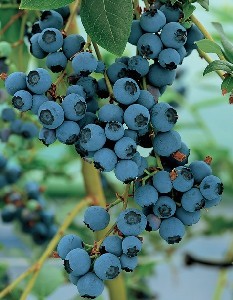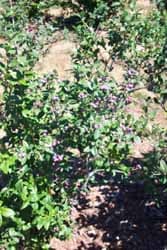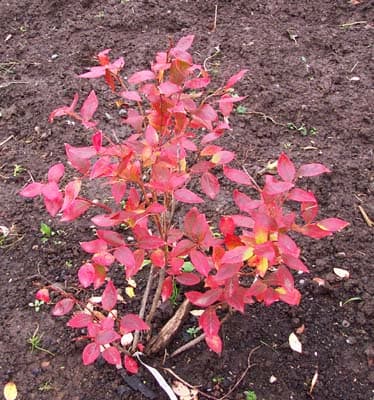How to Grow Blueberry Bushes

About Growing Blueberry Bushes in Your Garden
Delicious and nutritious…. growing blueberry bushes reward you with a real treat. What more could a gardener ask for? Well, for starters, I’d ask for the birds to stay away from them as they ripen. But, how can you blame them for enjoying this great and healthy summertime snack!?
Many fruit trees are simply too big and require too much maintenance, for the average homeowner’s backyard. Not so with a blueberry bush. Once your blueberry bush is planted and established, it will grow well for years with a little sunshine, water, and an occasional shot of fertilizer.
The month of July is Blueberries Month. That’s because the blueberry harvest in most areas of the country is in July.
Native to North America, the natives called them “Star Berries’, as the blossom end has five points resembling a star.
Varieties of Blueberries – There’s a wide variety of blueberries. Some bushes grow over six feet tall, while others can be grown in a container on your patio or deck. See Varieties of Blueberries
Health Benefits of Blueberries
High in fiber and loaded with antioxidants, Blueberries have many health benefits. They are the healthiest of all fruits. Health benefits include:
Helps lower cholesterol for better heart health
Reduces the risk of cancer, especially colon and liver cancer
Reduces belly fat
Helps fight disease
Slows the body’s aging process
Promotes brain health, including fights against Alzheimer’s
Improves digestion
Preserves vision
Did You Know? There are only about 80 calories in a cup of blueberries.

How to Grow Blueberry Bushes
Select healthy, young blueberry bushes from a reputable nursery or garden supply store.
Did You Know? Most varieties of blueberry bushes require two different varieties to properly pollinate and produce berries.
Plant the bushes in the spring. Blueberry bushes grow best in full sun. They like clay and other poor or rocky soils.
IMPORTANT: Getting the soil pH right, is perhaps the most important thing to successfully growing blueberry bushes. The bushes are acid-loving plants. To grow healthy bushes, you may need to increase the acidity in your soil, to grow healthy bushes. More on soil pH
Space blueberry bushes about five to six feet apart. We recommend rows eight to ten feet apart. The bushes tolerate a little crowding.
Mix in healthy amounts of compost and other organic matter. Keep a thick layer of mulch around your blueberry bushes to eliminate weeds, and help keep the soil moist.
Water well after planting, and in the first few weeks as necessary, to promote good root growth.
Now the waiting begins. A new blueberry bush first produces fruit in 2-3 years! After that, your bush will thrive for many years to come, with just a little care and maintenance.
Add fertilizer once in the spring and again in late summer. The latter application helps to promote buds for next year.
Blueberry bushes put on a spectacular fall foliage display. The leaves on a Blueberry bush turn a colorful rust-red color. (see above)
These hardy bushes need no special protection in the winter.
Ideal Soil pH:. 4. 0 – 6.0.

Harvesting Blueberries
As the blueberries ripen, harvest them every two to three days. Place a container under the fruit. Then, gently rub the berries. The ripe ones will fall off into the container. The unripe ones will stay on the bush.
Freezing blueberries is a cinch. Pick them, place them in a sealable freezer bag and stick them in the freezer. They thaw in minutes.
Pruning Blueberry Bushes
Buds for next year’s fruit forms in late summer through early fall. Blueberry buds for next year will form on second-year wood. Keep this in mind when pruning. Pruning is recommended in the winter. As you prune the newest growth, you are reducing production for the following year. As you cut well down an established stalk, you are reducing fruit production for the upcoming year.
So, what does a home gardener do? First and foremost, remove any dead or diseased branches and stems. Then, cut away a few stalks from bushy plants. Good air circulation is essential to plant health. Next, trim back your bush to maintain an acceptable height. Be careful not to cut away more than 1/2 of the newest growth.
Keep in mind pruning leads to healthier plants and fewer, but bigger berries.
Birds and Blueberries
Forget the story of the birds and the bees. We’re talking about the “birds and the blueberries”. Birds absolutely love blueberries. Home gardeners and commercial growers quickly find this out. And, those birds can be so smart! I realized this one day, as I walked amidst the blueberry field of a farmer friend of mine. He had bought an expensive sound system, which alternately played a variety of predator bird sounds and calls. I watched as a small flock of birds munched on plump blueberries, on bushes right next to a speaker.
If you are going to grow blueberries, you need a plan of attack to keep the birds away. One approach is to simply share your fruit with them. As a fellow bird lover, this may not sound too bad. But, you will need several blueberry bushes, to keep your family and the birds satisfied.
We recommend you make those birds feel blue. Take the fruit of your labor away from them. The most effective means of control, short of a shotgun, is bird netting placed over the bushes. It is relatively inexpensive and will last for a few years.
Bird Netting and Frames – Learn about bird netting and easy to make frames.
Blueberry Recipes
Related Articles
Please support our site. Shop for:
- rmmatthews100@hotmail.com
- 585-721-6528
- Rochester, NY
©1999-2024 GardenersNet.Com, All Rights Reserved

